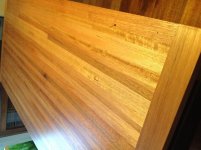I'd imagine that E globulus is a genuine contender for the most numerous tree on earth. Thanks to its ubiquity as a plantation spp. It's not just in Cali that it's considered an invasive pest spp. either. In other parts of both Americas, throughout the South Asian subcontinent, S.E. Asia, Southern, N.W. & the horn of Africa & the Iberian peninsula there's countless millions of hectares planted & now (unfortunately) self-sown.
It's ideally suited to impoverished, esp. acidic & low phosphorous soils, has an extraordinary deep root system that seeks out & depletes aquifers, rice paddies, whatever & has an allelopathic (toxic) effect on much native vegetation. Growing on better sites to over 100m in height, competing native vegetation doesn't stand a chance. The strong, volatile eucalyptus oil bearing leaves, extreme drought tolerance and not just fire resistance but active wildfire propagation characteristics (long candlebark, dead staghead old-growth form, highly inflammable oily soft tissues with thick, deep insulative bark makes large old growth stands a distinct (even extreme) fire hazard.
Taxonomically speaking, it's just about the "perfect weed". That its timber is strong, hard & beautiful, its soft tissues perfect for oil distillation, excellent for firewood, shipbuilding, wharf piles & railroad sleepers makes it just too darned useful too. For every local environmentalist decrying its negatives there's whole local third world economies & communities benefiting from its presence. Addis Ababa (Ethiopia) was, until Blue gums were planted, a hot, treeless, virtually shadeless "desert" stripped of virtually all vegetation for fuelwood & goat fodder. Blue gum was used to help the British Empire expand its naval installations & railroads across vast swathes of Africa & South Asia. It helped (in its humble way) to build the Empire.
Not bad for my state's floral emblem that here only exists in small, isolated, non-contiguous stands.


